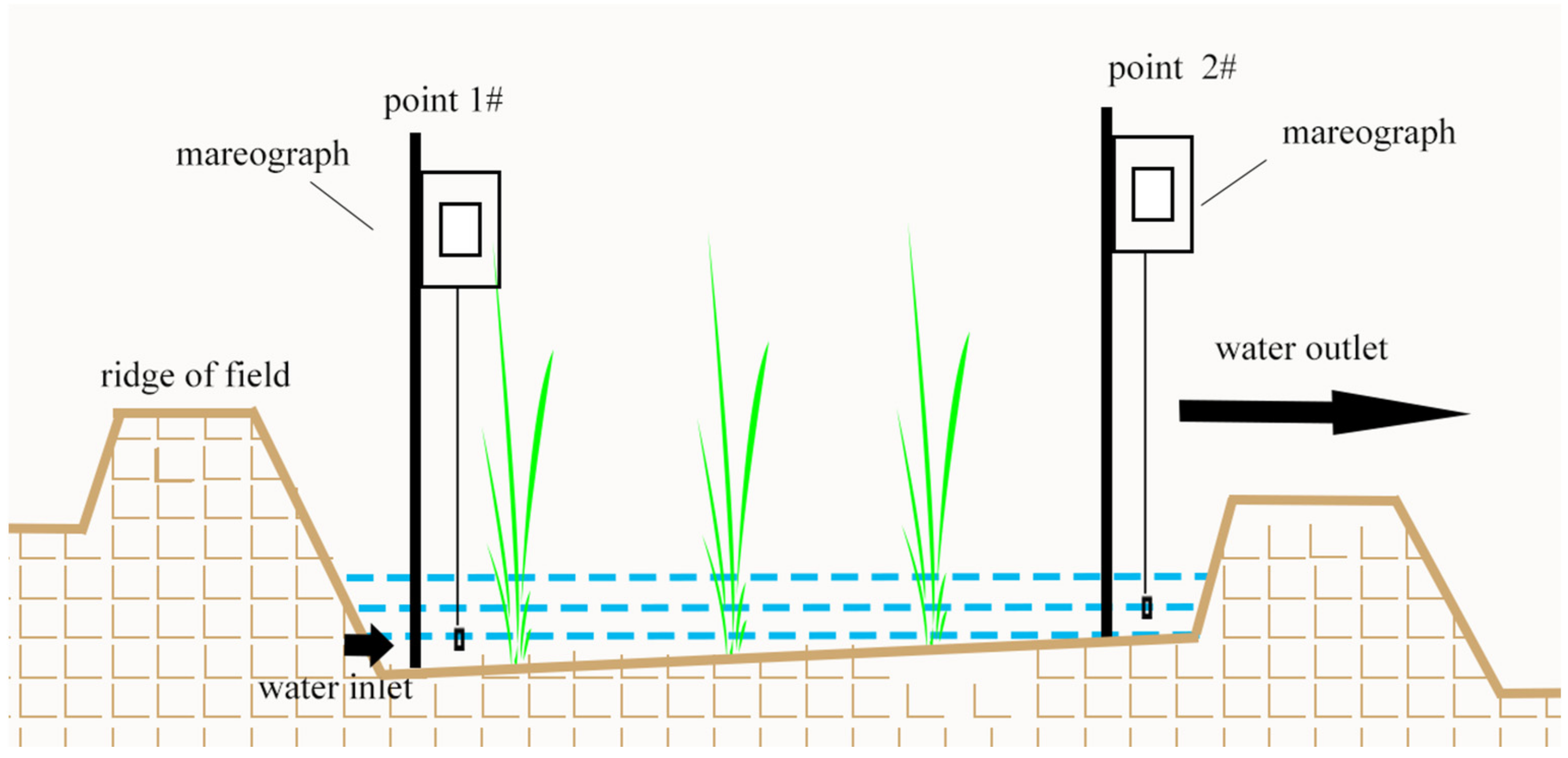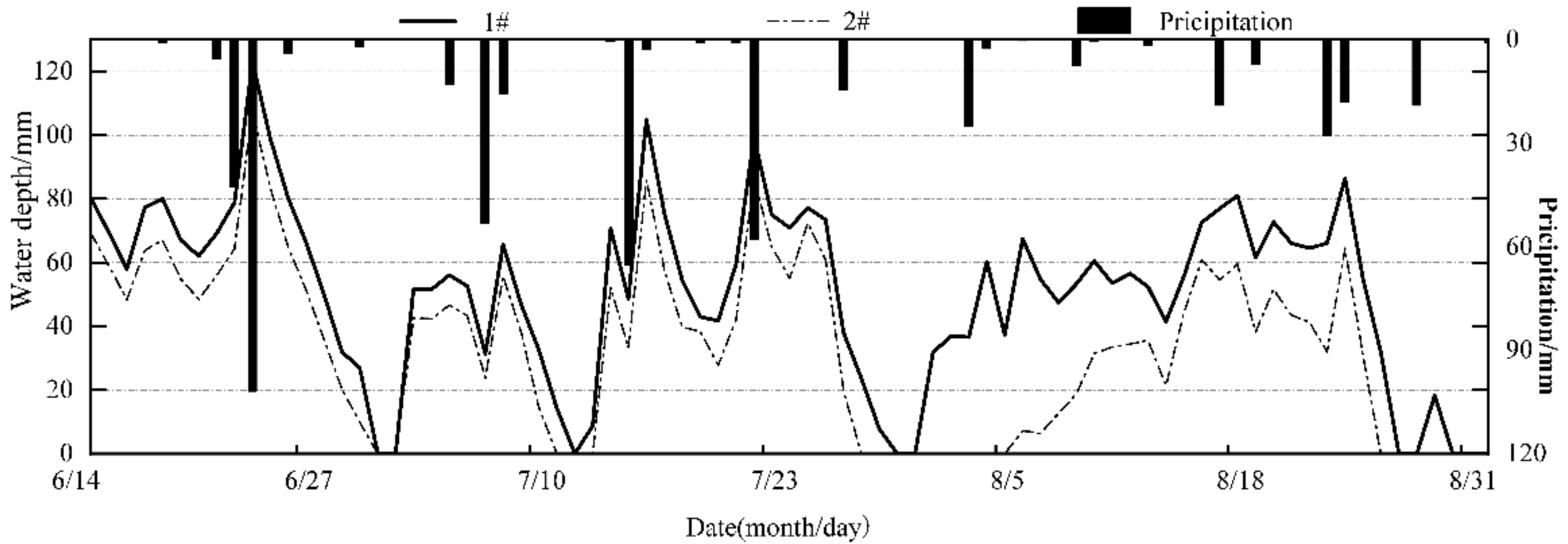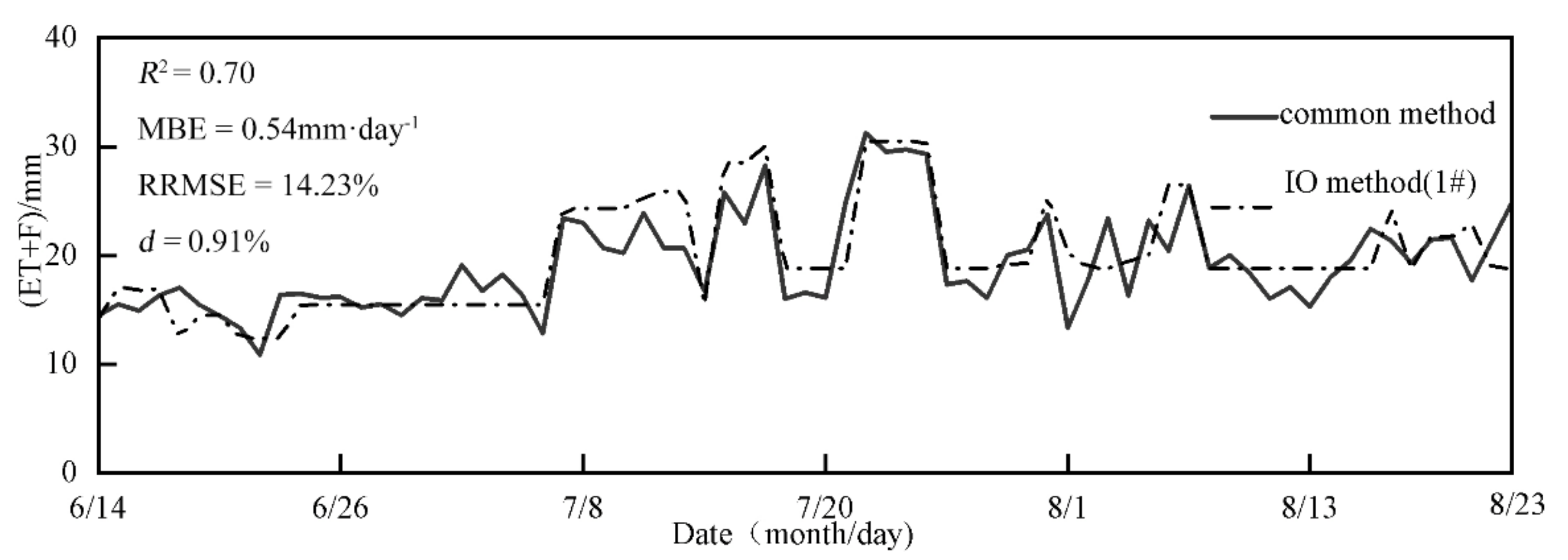Validation of an In-Situ Observation Method for Nonpoint Source Pollution in Paddy Fields: A Case Study of a Beijing Paddy Field
Abstract
:1. Introduction
2. Methods and Data
2.1. Experimental Site
2.2. Data Collection
2.3. Data Analysis Methods
2.3.1. Runoff Calculation from the Paddy Field
2.3.2. (ET+F) Estimation by the IO Method
2.3.3. ET Caculation by the Common Method
- 1.
- Reference crop evapotranspiration (ET0)
- 2.
- The rice coefficient (KC)
2.3.4. Infiltration (F) Calculation by the Common Method
- (1)
- When Hi > 0, it is assumed that there is a linear relationship between F and the depth of the field water layer.where Si is the infiltration in paddy fields (mm) of day i, a and b are fitting parameters, with a = 0.09 and b = 2.58.
- (2)
- When Hi = 0. At the later stage of rice growth, there is often no water layer on the field surface. At this time, since the soil moisture content in the paddy field is higher than the water holding rate in the field, the soil water content in the root layer of rice still decreases significantly, and the F value can be calculated according to Equation (8):where Si is the infiltration of the paddy field on day i, mm; and K0 is the saturated hydraulic conductivity (m/d), which is mainly related to the soil texture, which is generally 0.1~1.0 m/d. α is an empirical constant, generally ranging from 50 to 250, ti is the time when the saturated soil moisture content reaches level (d), and H is the depth of the rice main root layer (m).
2.3.5. Accuracy Analysis
2.3.6. Runoff Pollution Calculation
3. Results and Discussion
3.1. Analysis of Evapotranspiration and Infiltration Loss
3.1.1. Comparison of (ET+F) between Points 1# and 2#
3.1.2. Comparison of ET+F between IO and Common Methods
3.2. Outflow Calculation
3.3. Comparison of Pollutant Loss Load
3.4. Analysis of the Factors Affecting the Concentration of Pollutants
4. Conclusions
- (1)
- Using the in-situ observation (IO) methods in different locations with large elevation differences to study NPS pollution in paddy fields, 1# observation point was located at a lower position compared with 2# observation point. According to 1# observation point, there were 5 days of dry field in the drying period, which was consistent with the actual drying period, and there was a dry period of 9 days based on 2# observation point. We found that water depth data are the key to applying IO methods for evapotranspiration and infiltration loss estimation and runoff identification.
- (2)
- It is recommended that mareographs be installed in relatively low-lying areas of paddy fields to ensure that the water depth variation during the rice-growing season can be fully monitored.
- (3)
- The paddy field experienced 4 rainfall runoffs and 3 irrigation return flows based on observations at points 1# and 2#. The highest farmland outflow occurred in late June, reaching 261.4 mm and 267 mm based on observations at locations 1# and 2#, respectively. The installation location of the water level gauge has little effect on the use of the IO method. The IO method of installing water level meters in low-lying areas allows for more accurate measurement of NPS pollution in paddy fields.
- (4)
- The relative deviation of the NPS pollution of total nitrogen (TN), total phosphorus (TP), chemical oxygen demand (COD), nitrate-nitrogen (NO3−-N) and ammonia nitrogen (NH4+-N) was between 0.6% and 2.0%.
- (5)
- Among NPS caused by the outflow of rice fields, the pollutant concentration distribution at points 1# and 2# was uneven, and it is recommended to sample near the main radial outlet to ensure that the measured pollutant concentration is representative.
Author Contributions
Funding
Institutional Review Board Statement
Informed Consent Statement
Data Availability Statement
Conflicts of Interest
References
- Xin, F.; Xiao, X.; Dong, J.; Zhang, G.; Zhang, Y.; Wu, X.; Li, X.; Zou, Z.; Ma, J.; Du, G.; et al. Large increases of paddy rice area, gross primary production, and grain production in Northeast China during 2000–2017. Sci. Total Environ. 2020, 711, 135183. [Google Scholar] [CrossRef]
- Zhuang, Y.; Liu, H.; Zhang, L.; Li, S. Research perspectives on paddy field systems: Ecological functions and environ-mental impacts. Int. J. Agric. Sustain. 2020, 18, 505–520. [Google Scholar] [CrossRef]
- Carpenter, S.R.; Caraco, N.F.; Correll, D.L.; Howarth, R.W.; Sharpley, A.N.; Smith, V.H. Nonpoint pollution of surface waters with phosphorus and nitrogen. Ecol. Appl. 1998, 8, 559–568. [Google Scholar] [CrossRef]
- Zhao, J.; Zhao, Y.; Zhao, X.; Jiang, C. Agricultural runoff pollution control by a grassed swales coupled with wetland detention ponds system: A case study in Taihu Basin, China. Environ. Sci. Pollut. Res. 2016, 23, 9093–9104. [Google Scholar] [CrossRef]
- Papadakis, E.-N.; Tsaboula, A.; Vryzas, Z.; Kotopoulou, A.; Kintzikoglou, K.; Papadopoulou-Mourkidou, E. Pesticides in the rivers and streams of two river basins in northern Greece. Sci. Total Environ. 2018, 624, 732–743. [Google Scholar] [CrossRef]
- Hou, X.; Zhou, F.; Leip, A.; Fu, B.; Yang, H.; Chen, Y.; Gao, S.; Shang, Z.; Ma, L. Spatial patterns of nitrogen runoff from Chinese paddy fields. Agric. Ecosyst. Environ. 2016, 231, 246–254. [Google Scholar] [CrossRef]
- Wang, Z.; Wan, L.; Xu, C.M. Spectrums of Nitrogen and Phosphorus Leaching Loss from Different Land-Use Types. CLEAN Soil Air Water 2018, 46, 1700538. [Google Scholar] [CrossRef]
- Luo, Y.; Khan, S.; Cui, Y.; Peng, S. Application of system dynamics approach for time varying water balance in aerobic paddy fields. Paddy Water Environ. 2009, 7, 1–9. [Google Scholar] [CrossRef]
- Jeon, J.-H.; Yoon, C.G.; Ham, J.-H.; Jung, K.-W. Model Development for Nutrient Loading Estimates from Paddy Rice Fields in Korea. J. Environ. Sci. Health Part B Pestic. Food Contam. Agric. Wastes 2004, 39, 845–860. [Google Scholar] [CrossRef]
- Rajaei, F.; Sari, A.E.; Salmanmahiny, A.; Delavar, M.; Bavani, A.R.M.; Srinivasan, R. Surface drainage nitrate loading estimate from agriculture fields and its relationship with landscape metrics in Tajan watershed. Paddy Water Environ. 2016, 15, 541–552. [Google Scholar] [CrossRef]
- Cui, N.; Cai, M.; Zhang, X.; Abdelhafez, A.A.; Zhou, L.; Sun, H.; Chen, G.; Zou, G.; Zhou, S. Runoff loss of nitrogen and phosphorus from a rice paddy field in the east of China: Effects of long-term chemical N fertilizer and organic manure applications. Glob. Ecol. Conserv. 2020, 22, e01011. [Google Scholar] [CrossRef]
- Xiao, M.; Li, Y.; Wang, J.; Hu, X.; Wang, L.; Miao, Z. Study on the Law of Nitrogen Transfer and Conversion and Use of Fertilizer Nitrogen in Paddy Fields under Water-Saving Irrigation Mode. Water 2019, 11, 218. [Google Scholar] [CrossRef] [Green Version]
- Chun, J.A.; Cooke, R.A.; Kang, M.S.; Choi, M.; Timlin, D.; Park, S.W. Runoff Losses of Suspended Sediment, Nitrogen, and Phosphorus from a Small Watershed in Korea. J. Environ. Qual. 2010, 39, 981–990. [Google Scholar] [CrossRef] [Green Version]
- Xin, Y.; Liu, G.; Xie, Y.; Gao, Y.; Liu, B.; Shen, B. Effects of soil conservation practices on soil losses from slope farm-land in northeastern China using runoff plot data. Catena 2019, 174, 417–424. [Google Scholar] [CrossRef]
- Cherobim, V.F.; Huang, C.-H.; Favaretto, N. Tillage system and time post-liquid dairy manure: Effects on runoff, sediment and nutrients losses. Agric. Water Manag. 2017, 184, 96–103. [Google Scholar] [CrossRef] [Green Version]
- Huang, N.-B.; Su, B.-L.; Li, R.-R.; Yang, W.-Z.; Shen, M.-M. A field-scale observation method for non-point source pollution of paddy fields. Agric. Water Manag. 2014, 146, 305–313. [Google Scholar] [CrossRef]
- Xu, Y.; Su, B.; Wang, H.; He, J.; Yang, Y. Analysis of the water balance and the nitrogen and phosphorus runoff pollution of a paddy field in situ in the Taihu Lake basin. Paddy Water Environ. 2020, 18, 385–398. [Google Scholar] [CrossRef]
- Phong, T.K.; Nguyen, M.H.; Komany, S.; Vu, S.H.; Watanabe, H. Alternative water management for controlling simetryn and thiobencarb runoff from paddy fields. Bull. Environ. Contam. Toxicol. 2006, 77, 375–382. [Google Scholar] [CrossRef]
- Xu, Y.; Su, B.; Wang, H.; He, J. A new method for indirectly estimating infiltration of paddy fields in situ. Proc. Int. Assoc. Hydrol. Sci. 2018, 379, 205–210. [Google Scholar] [CrossRef] [Green Version]
- Liu, W.; Zhang, B.; Han, S. Quantitative Analysis of the Impact of Meteorological Factors on Reference Evapotranspiration Changes in Beijing, 1958–2017. Water 2020, 12, 2263. [Google Scholar] [CrossRef]
- Liu, C.-W.; Cheng, S.-W.; Yu, W.-S.; Chen, S.-K. Water infiltration rate in cracked paddy soil. Geoderma 2003, 117, 169–181. [Google Scholar] [CrossRef]
- Liu, C.-W.; Chen, S.-K.; Jang, C.-S. Modelling water infiltration in cracked paddy field soil. Hydrol. Process. 2004, 18, 2503–2513. [Google Scholar] [CrossRef]
- Jiang, S.; Liang, C.; Cui, N.; Zhao, L.; Liu, C.; Feng, Y.; Hu, X.; Gong, D.; Zou, Q. Water use efficiency and its drivers in four typical agroecosystems based on flux tower measurements. Agric. For. Meteorol. 2020, 295, 108200. [Google Scholar] [CrossRef]
- Khepar, S.D.; Yadav, A.K.; Sondhi, S.K.; Siag, M. Water balance model for paddy fields under intermittent irrigation practices. Irrig. Sci. 2000, 19, 199–208. [Google Scholar] [CrossRef]
- Pereira, L.S.; Allen, R.G.; Smith, M.; Raes, D. Crop evapotranspiration estimation with FAO56: Past and future. Agric. Water Manag. 2015, 147, 4–20. [Google Scholar] [CrossRef]
- López-Urrea, R.; Martín de Santa Olalla, F.; Fabeiro, C.; Moratalla, A. Testing evapotranspiration equations using lysimeter observations in a semiarid climate. Agric. Water Manag. 2006, 85, 15–26. [Google Scholar] [CrossRef]
- Rahimikhoob, H.; Sohrabi, T.; Delshad, M. Assessment of reference evapotranspiration estimation methods in controlled greenhouse conditions. Irrig. Sci. 2020, 38, 389–400. [Google Scholar] [CrossRef]
- Wu, G.; Li, L.; Ahmad, S.; Chen, X.; Pan, X. A Dynamic Model for Vulnerability Assessment of Regional Water Re-sources in Arid Areas: A Case Study of Bayingolin, China. Water Resour. Manag. 2013, 27, 3085–3101. [Google Scholar] [CrossRef]
- Chicco, D.; Warrens, M.J.; Jurman, G. The coefficient of determination R-squared is more informative than SMAPE, MAE, MAPE, MSE and RMSE in regression analysis evaluation. PeerJ Comput. Sci. 2021, 7, e623. [Google Scholar] [CrossRef]
- Muniandy, J.M.; Yusop, Z.; Askari, M. Evaluation of reference evapotranspiration models and determination of crop coefficient for Momordica charantia and Capsicum annuum. Agric. Water Manag. 2016, 169, 77–89. [Google Scholar] [CrossRef]
- Conversa, G.; Bonasia, A.; Di Gioia, F.; Elia, A. A decision support system (GesCoN) for managing fertigation in vegetable crops. Part II—Model calibration and validation under different environmental growing conditions on field grown tomato. Front. Plant Sci. 2015, 6, 495. [Google Scholar] [CrossRef] [Green Version]
- Zhou, M.; Li, Y.; Tahir, M.J.; Geng, X.; Wang, Y.; He, W. Integrated Statistical Test of Signal Distributions and Access Point Contributions for Wi-Fi Indoor Localization. IEEE Trans. Veh. Technol. 2021, 70, 5057–5070. [Google Scholar] [CrossRef]
- Gocic, M.; Petković, D.; Shamshirband, S.; Kamsin, A. Comparative analysis of reference evapotranspiration equations modelling by extreme learning machine. Comput. Electron. Agric. 2016, 127, 56–63. [Google Scholar] [CrossRef]
- Qi, D.; Yan, J.; Zhu, J. Effect of a reduced fertilizer rate on the water quality of paddy fields and rice yields under fishpond effluent irrigation. Agric. Water Manag. 2020, 231, 105999. [Google Scholar] [CrossRef]
- Qiao, J.; Yang, L.; Yan, T.; Xue, F.; Zhao, D. Nitrogen fertilizer reduction in rice production for two consecutive years in the Taihu Lake area. Agric. Ecosyst. Environ. 2012, 146, 103–112. [Google Scholar] [CrossRef]
- Zhao, C.; Huang, H.; Qian, Z.-H.; Jiang, H.-X.; Liu, G.-M.; Xu, K.; Hu, Y.-J.; Dai, Q.-G.; Huo, Z.-Y. Effect of side deep placement of nitrogen on yield and nitrogen use efficiency of single season late japonica rice. J. Integr. Agric. 2021, 20, 1487–1502. [Google Scholar] [CrossRef]
- Contreras, J.I.; Baeza, R.; Alonso, F.; Cánovas, G.; Gavilán, P.; Lozano, D. Effect of Distribution Uniformity and Fertigation Volume on the Bio-Productivity of the Greenhouse Zucchini Crop. Water 2020, 12, 2183. [Google Scholar] [CrossRef]
- Wang, L.J.; Yang, Y.; Zheng, J.J.; Liu, Y.N.; Guo, Q.K.; Wang, D.A.; Liu, B.Y. Effects of fertilization on nitrogen and phosphorous losses from cropland in Beijing Mountainous Area. Sci. Soil Water Conserv. 2017, 15, 97–104. [Google Scholar]
- Liu, X.; Chen, L.; Hua, Z.; Mei, S.; Wang, P.; Wang, S. Comparing ammonia volatilization between conventional and slow-release nitrogen fertilizers in paddy fields in the Taihu Lake region. Environ. Sci. Pollut. Res. 2020, 27, 8386–8394. [Google Scholar] [CrossRef]






| Statical Measures | Symbol | Meaning | Corresponding Equation | Value |
| Coefficient of determination | R2 | R2 indicates the dispersion of dependent variables around the regression line, high values of R2 criterion indicates perfect consistency of the computational methods with the actual conditions [28] | 0.70 | |
| Mean bias error | MBE | The MBE measures the average difference between two methods [29] | 0.54 mm day−1 | |
| Relative root mean square error | RRMSE | The performance of computational methods is considered excellent when the RRMSE is lower than 10%, good if between 10 and 20%, fair if between 20 and 30%, and poor if values are greater than 30% It shows overestimation or underestimation of each method and computes the errors in the same unit and scale [30] | 14.23% | |
| Index of agreement | d | The index of agreement as a descriptive measure indicating consistency between predicted and observed values [31] | 0.91 |
| Date | Pi/mm | Hi+1−Hi/mm | (ET+F)/mm | Rout/mm | Remarks | |||
|---|---|---|---|---|---|---|---|---|
| 1# | 2# | 1# | 2# | 1# | 2# | |||
| 23 June 2017 | 102 | 24 | 23.9 | 12.4 | 12.3 | 113.6 | 113.6 | Overflow |
| 7 July 2017 | 15.7 | 18.8 | 17.4 | 15.5 | 15.1 | 19 | 18 | Overflow |
| 15 July 2017 | 0 | 32.4 | 31.3 | 15.5 | 15.1 | 16.9 | 16.2 | Drainage |
| 21 July 2017 | 58.2 | 24.4 | 21.8 | 18.8 | 18.1 | 63.8 | 61.9 | Overflow |
| 26 July 2017 | 14.8 | 14.3 | 19.8 | 18.8 | 18.1 | 10.3 | 16.5 | Overflow |
| 2–3 August 2017 | 27.9 | 0 | 0 | 18.8 | 18.1 | 6.9 | 7.1 | Overflow |
| 23 August 2017 | 18.1 | 49.7 | 51.8 | 18.8 | 18.1 | 30.9 | 33.7 | Overflow |
| Date | Rout/mm | COD (mg) | NH4+-N (mg) | NO3−-N (mg) | TN (mg) | TP (mg) | |||||
|---|---|---|---|---|---|---|---|---|---|---|---|
| 1# | 2# | 1# | 2# | 1# | 2# | 1# | 2# | 1# | 2# | ||
| 23 June 2017 | 113.60 | 50,765.00 | 50,765.00 | 238.36 | 238.36 | 150.11 | 150.11 | 1261.77 | 1261.77 | 415.86 | 415.86 |
| 7 July 2017 | 19.00 | 3104.46 | 2941.07 | 63.62 | 60.27 | 16.46 | 15.59 | 238.01 | 225.48 | 40.38 | 38.25 |
| 15 July 2017 | 16.90 | 2248.30 | 2155.18 | 11.77 | 11.28 | 3.62 | 3.47 | 76.35 | 73.19 | 22.48 | 21.55 |
| 21 July 2017 | 63.80 | 13,756.88 | 13,347.19 | 79.75 | 77.38 | 0.00 | 0.00 | 474.51 | 460.38 | 115.64 | 112.19 |
| 26 July 2017 | 10.30 | 1496.72 | 2397.66 | 35.41 | 56.72 | 0.00 | 0.00 | 91.09 | 145.92 | 15.45 | 24.75 |
| 2–3 August 2017 | 6.90 | 819.38 | 843.13 | 37.09 | 38.16 | 2.59 | 2.66 | 62.10 | 63.90 | 9.49 | 9.76 |
| 23 August 2017 | 30.90 | 9076.88 | 9899.38 | 113.94 | 124.27 | 7.73 | 8.43 | 415.22 | 452.84 | 131.33 | 143.23 |
| Total | 81,267.61 | 82,348.59 | 579.93 | 606.43 | 180.50 | 180.26 | 2619.05 | 2683.49 | 750.62 | 765.59 | |
| Export coefficient | 135.45 | 137.25 | 0.97 | 1.01 | 0.30 | 0.30 | 4.37 | 4.47 | 1.25 | 1.28 | |
Publisher’s Note: MDPI stays neutral with regard to jurisdictional claims in published maps and institutional affiliations. |
© 2021 by the authors. Licensee MDPI, Basel, Switzerland. This article is an open access article distributed under the terms and conditions of the Creative Commons Attribution (CC BY) license (https://creativecommons.org/licenses/by/4.0/).
Share and Cite
Liao, Y.; He, J.; Su, B.; Dou, J.; Xu, Y.; Li, L. Validation of an In-Situ Observation Method for Nonpoint Source Pollution in Paddy Fields: A Case Study of a Beijing Paddy Field. Water 2021, 13, 3235. https://doi.org/10.3390/w13223235
Liao Y, He J, Su B, Dou J, Xu Y, Li L. Validation of an In-Situ Observation Method for Nonpoint Source Pollution in Paddy Fields: A Case Study of a Beijing Paddy Field. Water. 2021; 13(22):3235. https://doi.org/10.3390/w13223235
Chicago/Turabian StyleLiao, Ya, Jingyi He, Baolin Su, Junfeng Dou, Yunqiang Xu, and Lifen Li. 2021. "Validation of an In-Situ Observation Method for Nonpoint Source Pollution in Paddy Fields: A Case Study of a Beijing Paddy Field" Water 13, no. 22: 3235. https://doi.org/10.3390/w13223235






